Basnyat family
| Basnyat /Basnyat noble family बस्न्यात वंश/बस्न्यात काजी खलक | |
|---|---|
| Country |
Gorkha Kingdom Kingdom of Nepal |
| Ethnicity | Khas Kshatriya (Chhetri) |
| Founded | 18th century |
| Founder | Shivaram Singh Basnyat |
| Current head | currently as pretender |
| Final ruler | multiple |
| Titles | Title of Kaji |
| Style(s) |
|
| Religion | Hinduism |
| Estate(s) | Tilanga Ghar |
| Deposition | 1846 |
| Basnet | |
|---|---|
| Language(s) | Nepali, Doteli, Kumaoni |
| Origin | |
| Language(s) | Khas |
| Word/Name | Karnali, Nepal |
| Meaning | Unknown |
| Other names | |
| Variant(s) | Basnyat, Basnyet |
| See also | Pande, Thapa, Rana, Karki, Khadka |
| Families | |
| Basnyat family | |
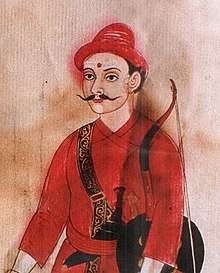
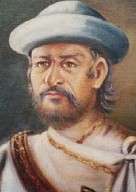
Basnyat family or Basnyat (Nepali: बस्न्यात वंश/बस्न्यात काजी खलक) was a Kshatriya (Chhetri) family in the Gorkha Kingdom and Kingdom of Nepal.[1][2] This family was part of Thar Garh aristocracy group: one of the four noble family to be involved in active politics of Nepal together with Shah dynasty, Pande family and Thapa before the rise of Rana.[1] This family was maritally linked to Kala (Black) Pande section of Pande family through Chitravati Pande who married Kaji Kehar Singh Basnyat.[3] This family was the last Kshatriya (Chhetri) political family to be wiped out by Jung Bahadur Rana during the Bhandarkhal Massacre.[4]
Basnet/Basnyat (Nepali: बस्नेत/बस्न्यात) continues as a surname of a particular Hindu family of Nepal and India.[5]
Basnyat of Shreepali clan rose during rule of King Prithvi Narayan Shah in the Gorkha Kingdom. Senapati Badabir Shivaram Singh Basnyat was the son of Jayaram Singh Basnyat, a Shreepali Basnyat of Gorkha.[6]
There are five different branches of Basnets in Nepal:
- The Shreepali (Sripali) Jumli Basnets of Jumla bharadwaja later Gorkha.
- The Khaptari (Khaptadi) Basnet of Khaptad Kaushik gotriya Basnyats
- The Khulal Basnets; Dhananjay gotriya Basnyats
- The Lamichhane; Garga gotriya Basnets
- The Balami Basnets[7]
Background
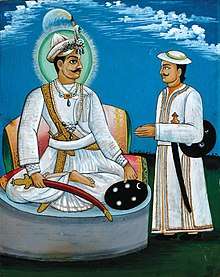
Basnyats were part of Tharghar aristocratic group which assisted the rulers of the Kingdom of Gorkha and played significant roles in the Unification of Nepal.[8] Basnets were not initially included in the Tharghar aristocracy group but got entry during the rule of King Prithvi Narayan Shah together with Thapas.[8] Shivaram Singh Basnyat, the commander of Gorkhali forces, was the son of Jaya Ram Singh Basnyat, a Shreepali Basnyat of Gorkha.[6]
King Prithvi Narayan Shah formed an alliance with Basnyat and Pande families of Gorkha in his quest for the unification of Nepal.[9] As per his Divya Upadesh, King Prithvi Narayan is known to have arranged the marriage between Kaji Kehar Singh Basnyat, the second son of Senapati Badabir Shivaram Singh Basnyat, and Chitra Devi, the daughter of Kaji Kalu Pandey.[9][3] Shivaram Singh Basnyat was addressed as Senapati Badabir (Brave Chief of the Army) in all the documents of that era. He died in the defensive battle of Sanga Chowk during Unification of Nepal on 1803 B.S.[10][11] Shivram Singh became the first major military leader of Gorkha who was martyred even before Kaji Kalu Pande in the campaign of unification of Nepal. Later, Birangana Shoorprabha Basnyat, widow of Shivram Singh, constructed the Narayan temple in Timal Danda (Kavre) in honour of her husband Senapati Badabir Shivram Singh. 'Birangana' Shoorprabha was a daughter of Bagale Thapa of Gorkha, who raised her four brave sons after the early martyrdom of her husband.The story of Shoor Prabha is written by former Vice Chancellor late Rudra Raj Pandey in his epic "Nepal ka Bir Birangana Haru".
Kazi Naahar Singh Basnyat, first son of Shivram, fought in the battle of Makwanpur against the forces of Mir Kasim. He was a major military leader in the battle to capture Kantipur, Patan and Bhadgaun in 1826 B.S. along with his three younger brothers. He also fought in the battle of Tibet in 1845 B.S.

Kazi Kehar Singh went to Tibet to negotiate with it to have the Nepali coins circulated in Tibet. He was the major military/civilian leader who united the western districts and Kathmandu valley to Nepal. He was instrumental in annexing Kathmandu, Patan, Bhaktapur and Kirtipur. His contribution to unify Nepal is incomparable. He was appointed Chief Administrator of Patan immediately after it was annexed to Nepal. King Prithvi Narayan Shah waged war against western Chaubise (24) Confederacy on 1770 under military leadership of Kaji Vamsharaj Pande, Kaji Kehar Singh Basnyat and Sardar Prabhu Malla and achieved initial success.[12][13] On 1771, the Gorkhali forces lost the war against Chaubise (24) principalities and Kaji Kehar Singh Basnyat died in the battlefield.[14][15]
Abhiman Singh Basnyat,born on 14 Falgun 1801 B.S., the third son of Senapati Badabir Shivaram Singh Basnyat became the second Commander in Chief of a United Nepal. Abhiman's two elder brothers were Kazi Naahar Singh and Kazi Kehar Singh. His youngest brother Kazi Dhokal Singh Basnyat, who also became the governor of Kumaun Gadwal, was the first owner of present Narayanhity Palace area known as Kirti Mandir at that time. Stone inscription about this is still there inside Narayanhity Palace compound. Abhiman Singh died at the age of fifty-six in Ashad 1857 B.S. when he was sent to settle the area of Morang and Sunsari,then called Kaala Banzaar. He had delivered the jamindari power to tharu and honored with the title of chaudhari. It was a great injustice to him to have been assigned by King Rana Rahadur Shah to this area of dense forests at that old age when he was already a Mulkazi. It was because of Abhiman's displeasure about the marriage of Rana Bahadur with the child Brahmin widow Kantivati. He was reported to have suffered from fever, possibly Malaria and died of it. Despite the Basnyat family's immense contribution to Nepal's Unification, nobody from Basnyat family was declared Rastriya Bibhuti (National Hero).We cannot undermine the sacrifice made by the brave Basnyat family of six members at that time namely Shivram, Shoor Prabha, Naahar, Kehar,Abhiman and Dhaukal in the unification campaign of King Prithvi Narayan Shah. There were other Basnyats of Shreepali origin such as Ranya (Bangya) Basnyat, Jitman, Bir Dhwaj Basnyat, Indra Bir, Banka Bir, Ranadip Singh, Rana Dhir Singh, Jahar Singh, Kirti Man Singh, Bakhtabar Singh, Bakhat Singh, Kul Man Singh, Prasad Singh etc. who fought or sacrificed their life in various battles and wars for the protection of Nepal's sovereignty in the later periods of Nepalese history. Researchers are suggested to read the book jointly written by late Lt. Col. Hanuman Singh Basnyat and late Purna Man Singh Basnyat entitled "Shreepali Basnyat-Parichaya, Published in 2058 BS for details.
King Prithvi Narayan Shah has stressed the importance of the Basnyats in his historic piece known as "Dibya Upadesh" or "Divine Counsel" in English. Here is a link to the translation of the "Dibya Upadesh" into English. This translation was done by Prawin Adhikari, from a transcription originally published by historian Baburam Acharya from Bakhat man Singh Basnyat. Samudaya.org owns the copyrights to the article.
A quote from the Dibya Upadesh:
It said—"Now, I will make ties between the Pandes and the Basnyats, so give your daughter to Sivaram Basnyat's son Kehar Singh Basnyat," and the two houses were tied by marriage. Thus, after the conjugal tie, with the shields of the Pandes and the swords of the Basnyats I attacked Nepal.
After the royal palace moved from Gorkha to Basantapur in Kathmandu, the Shreepali Basnyats of Gorkha moved along with the royal family, living close by the palace in Indra Chowk and Ason. Kazi Abhiman Singh constructed a house in 1833 B.S. for himself in Ason, Kathmandu, which is known as Maan Mandir, which still exists as Tilanga Ghar or Paltan Ghar. This Tilanga Ghar should be declared the National Heritage of Nepal and needs to be renovated. Basnyats shared a great amount of power in the court alongside the Pandeys and Thapas. This continued until the reign of King Rana Bahadur Shah, when Prime Minister Bhimsen Thapa came into power and there was a power struggle between the Pandeys and the Thapas. The Basnyats sided with the Pandeys as they had earlier marital links with them back in Gorkha.
Third generation of Basnyats
Kirtiman Singh, Bakhtawar Singh and Jahar Singh were the sons of Kehar Singh Basnyat.[16] Two of them became Mulkaji of Nepal after their uncle Abhiman Singh Basnyat. Jahar Singh became Kaji only in the annual Pajani (renewal) of 1825.[16] Abhiman's sons - Ranabir Singh and Ranadip Singh served mostly as a Sardar until in 1839, Ranadip being promoted to Kaji.[16] Dhokal Singh's son Ranadhir Singh became Kaji for three times in the year of 1819, 1829 and 1830.[16]
In 1794, King Rana Bahadur Shah came of age, and his first act was to re-constitute the government such that his uncle, Chief Chautaria Bahadur Shah of Nepal, had no official part to play.[17][18] After removal of Bahadur Shah of Nepal, Kirtiman Singh Basnyat was appointed as Chief (Mul) Kaji among the four Kajis though Damodar Pande was the most influential Kaji.[18] Kirtiman had succeeded Abhiman Singh Basnyat as Chief Kaji.[19] He was also a favorite of the Regent Subarna Prabha Devi.[20] He was secretly assassinated on 28 September 1801, by the supporters of Raj Rajeshwari Devi.[20] Another Kaji Damodar Pande was accused of the murder charges.[21] In the resulting confusion many courtiers were jailed, while some executed, based solely on rumors. Bakhtawar Singh Basnyat, brother of assassinated Kirtiman Singh, was then given the post of Mulkaji.[22] During his tenure as the Mulkaji, on 28 October 1801, a Treaty of Commerce and Alliance[note 1] was finally signed between Nepal and East India Company. This led to the establishment of the first British Resident, Captain William O. Knox, who was reluctantly welcomed by the courtiers in Kathmandu on 16 April 1802.[note 2][29] The primary objective of Knox's mission was to bring the trade treaty of 1792 into full effect and to establish a "controlling influence" in Nepali politics.[23] Almost eight months after the establishment of the Residency, Rajrajeshwari finally managed to assume the regency on 17 December 1802.[21][30] Rajrajeshowri's presence in Kathmandu also stirred unrest among the courtiers that aligned themselves around her and Subarnaprabha. Sensing an imminent hostility, Knox aligned himself with Subarnaprabha and attempted to interfere with the internal politics of Nepal.[31] Getting a wind of this matter, Rajrajeshowri dissolved the government and elected new ministers, with Damodar Pande as the Chief (Mul) Kaji on February 1803, while the Resident Knox, finding himself persona non grata and the objectives of his mission frustrated, voluntarily left Kathmandu to reside in Makwanpur citing a cholera epidemic.[31][23][21]
Fourth generation of Basnyats
The sons of Bakhtawar Singh Basnyat were the most prominent among their cousins. Kulaman Singh and Prasad Singh, two sons of Bakhtawar Singh, were regular Bharadar (state-bearering officer) between 1825 and 1839.[16] Kulaman Singh Basnyat was the only consistent Kaji from the Basnyat family between 1824 and 1839 while his brother Prasad Singh was Sardar from 1825 to 1838 before being promoted to Kaji in 1839.[16] Their less prominent brother Buddhiman Singh was a Sardar in 1825 and Kaji in 1838.[16] Jitman Singh, a son of Kirtiman Singh Basnyat, was a Kaji in the two tenures of 1818-1819 and 1834-1837.[16] Bakhan Singh, the son of Jahar Singh, was a Sardar and later Colonel for various tenure between 1816 and 1838.[16]
Basnyat family members
| No. | Members | Image | Position | Years in the position | Notes |
|---|---|---|---|---|---|
| 1 | Shivaram Singh Basnyat | 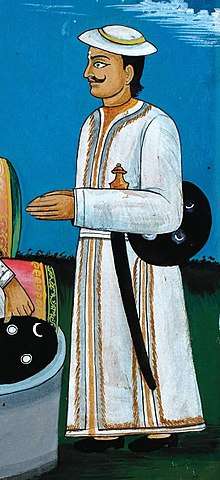 | Senapati of Gorkha Kingdom | up to 1747 A.D. | |
| 2 | Kehar Singh Basnyat | .jpg) | Kaji and commander | up to 1771 A.D. | second son of Shivaram Singh |
| 3 | Abhiman Singh Basnyat |  | Mulkaji (Prime Minister) and Commander-in-Chief | 1785 to 1794 A.D. | third son of Shivaram and head of Basnyats between 1785 and 1794 |
| 4 | Kirtiman Singh Basnyat | .jpg) | Mulkaji (Prime Minister) and Commander-in-Chief | 1794 to 1801 A.D. | son of Kehar Singh, succeeded his uncle Abhiman Singh during his lifetime |
| 5 | Bakhtawar Singh Basnyat | Mulkaji (Prime Minister) | 1801 to 1803 A.D. |
Other members
| No. | Members | Image | Position | Years in the position | Notes |
|---|---|---|---|---|---|
| 1 | Naahar Singh Basnyat | Military commander | first son of Shivaram Singh | ||
| 2 | Dhokal Singh Basnyat | Bada Hakim of Kumaon and Garhwal | fourth and youngest son of Shivaram Singh | ||
| 3 | Kulaman Singh Basnyat | Kaji (minister) | 1824 to 1839 A.D. | son of Bakhtawar Singh and most significant Basnyat courtier of fourth generation | |
| 4 | Prasad Singh Basnyat | Sardar and later Kaji (minister) | 1825 to 1838 A.D. (Sardar); 1839 onwards (Kaji) | son of Bakhtawar Singh | |
| 5 | Birdhwaj Basnyat | Kaji (minister) | up to 1846 A.D. | chief conspirator against Jung Bahadur Rana who fell at Bhandarkhal Parva (massacre) |
Gallery
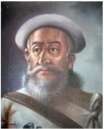 Shivaram Singh Basnyat
Shivaram Singh Basnyat Kulaman Singh Basnyat's signature as Kaji (minister)
Kulaman Singh Basnyat's signature as Kaji (minister)
References
- ↑ The treaty was signed by Gajraj Misra, on the behalf of Nepal Durbar, and Charles Crawford, on the behalf of East India Company, in Danapur, India. Among the articles in the treaty, it decided on perpetual peace and friendship between the two states, on the pension for Rana Bahadur Shah, the establishment of a British Residency in Kathmandu, and a establishment of trade relations between the two states.[23][24]
- ↑ Knox had previously accompanied Captain William Kirkpatrick in the 1792 British diplomatic mission to Nepal as a Lieutenant in charge of the military escort. In Knox's 1801 mission, he was accompanied by experts like the naturalist Francis Buchanan-Hamilton, who later published An Account of the Kingdom of Nepal in 1819, and the surveyor Charles Crawford, who made the first scientific maps of Kathmandu valley and of Nepal, and proposed that the Himalayas might be among the highest mountains in the world.[25][26][27][28]
Notes
- 1 2 Joshi & Rose 1966, p. 23.
- ↑ Joshi & Rose 1966, p. 25.
- 1 2 Regmi 1995, p. 44.
- ↑ Joshi & Rose 1966, p. 32.
- ↑ "Basnet Family Name". Retrieved 2017-03-25.
- 1 2 Hamal 1995, p. 182.
- ↑ "Nepali surnames, clans and gotra". Retrieved 2017-03-25.
- 1 2 Pradhan 2012, p. 21.
- 1 2 Acharya & Narharinath 2014.
- ↑ Shaha 1990, p. 27.
- ↑ Hamal 1995, p. 104.
- ↑ Shaha 2001, p. 59.
- ↑ Regmi 1975, p. 229.
- ↑ Vaidya 1993, p. 165.
- ↑ Mainali 2006, p. 74.
- 1 2 3 4 5 6 7 8 9 Pradhan 2012, p. 192.
- ↑ Acharya 2012, p. 14.
- 1 2 Pradhan 2012, p. 12.
- ↑ Karmacharya 2005, p. 56.
- 1 2 Acharya 2012, p. 34.
- 1 2 3 Pradhan 2012, p. 14.
- ↑ Acharya 2012, p. 35.
- 1 2 3 Amatya 1978.
- ↑ Nepal 2007, p. 51.
- ↑ Waller 2004, p. 174.
- ↑ "Francis Buchanan-Hamilton And His Pioneering Natural History Collections in Nepal in 1802–1803". Retrieved 7 November 2014.
- ↑ "Three maps of Nepal relating to the pioneering natural history collections of Francis Buchanan-Hamilton, 1802-3". Archived from the original on 31 December 2014. Retrieved 31 December 2014.
- ↑ Sorkhabi, Rasoul. "The Great Game of Mapping the Himalaya". Retrieved 31 December 2014.
- ↑ Pradhan 2012, p. 14; Nepal 2007, p. 51; Amatya 1978; Acharya 2012, pp. 35–36.
- ↑ Acharya 2012, pp. 36–37.
- 1 2 Acharya 2012, p. 43.
Sources
- Acharya, Baburam (2012), Acharya, Shri Krishna, ed., Janaral Bhimsen Thapa : Yinko Utthan Tatha Pattan (in Nepali), Kathmandu: Education Book House, p. 228, ISBN 9789937241748
- Amatya, Shaphalya (1978), "The failure of Captain Knox's mission in Nepal" (PDF), Ancient Nepal, Kathmandu (46–48): 9–17, retrieved Jan 11, 2013
- Joshi, Bhuwan Lal; Rose, Leo E. (1966), Democratic Innovations in Nepal: A Case Study of Political Acculturation, University of California Press, p. 551
- Pradhan, Kumar L. (2012), Thapa Politics in Nepal: With Special Reference to Bhim Sen Thapa, 1806–1839, New Delhi: Concept Publishing Company, p. 278, ISBN 9788180698132
- Nepal, Gyanmani (2007), Nepal ko Mahabharat (in Nepali) (3rd ed.), Kathmandu: Sajha, p. 314, ISBN 9789993325857
- Regmi, Mahesh Chandra (1978), Regmi Research Series
- Regmi, Mahesh Chandra (1995), Kings and political leaders of the Gorkhali Empire, 1768–1814, Orient Longman, p. 83, ISBN 9788125005117
- Acharya, Baburam, Naraharinath, Yogi (2014). Badamaharaj Prithivi Narayan Shah ko Divya Upadesh (2014 Reprint ed.). Kathmandu: Shree Krishna Acharya. ISBN 99933-912-1-2.
- Hamal, Lakshman B. (1995), Military history of Nepal, Sharda Pustak Mandir
- Mainali, Pramod (2006), Milestones of history, 2, Pramod Mainali, ISBN 9789994696048
- Vaidya, Tulsi Ram (1993), Prithvinaryan Shah, the founder of Nepal, Anmol Publications, ISBN 9788170417019
- Shaha, Rishikesh (2001), An Introduction of Nepal, Kathmandu: Ratna Pustak Bhandar
- Waller, Derek J. (2004) [1990], The Pundits: British Exploration of Tibet and Central Asia, University Press of Kentucky, p. 327, ISBN 9780813191003